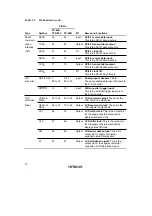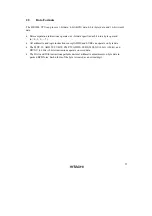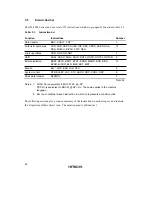
16
Bit 7—Interrupt Mask Bit (I): When this bit is set to 1, interrupts are masked. This bit is set to 1
automatically at the start of exception handling. The interrupt mask bit may be read and written
by software. For further details, see section 3.3, Interrupts.
Bit 6—User Bit (U): Can be used freely by the user.
Bit 5—Half-Carry Flag (H): When the ADD.B, ADDX.B, SUB.B, SUBX.B, CMP.B, or NEG.B
instruction is executed, this flag is set to 1 if there is a carry or borrow at bit 3, and is cleared to 0
otherwise.
The H flag is used implicitly by the DAA and DAS instructions.
When the ADD.W, SUB.W, or CMP.W instruction is executed, the H flag is set to 1 if there is a
carry or borrow at bit 11, and is cleared to 0 otherwise.
Bit 4—User Bit (U): Can be used freely by the user.
Bit 3—Negative Flag (N): Indicates the most significant bit (sign bit) of the result of an
instruction.
Bit 2—Zero Flag (Z): Set to 1 to indicate a zero result, and cleared to 0 to indicate a non-zero
result.
Bit 1—Overflow Flag (V): Set to 1 when an arithmetic overflow occurs, and cleared to 0 at other
times.
Bit 0—Carry Flag (C): Set to 1 when a carry occurs, and cleared to 0 otherwise. Used by:
•
Add instructions, to indicate a carry
•
Subtract instructions, to indicate a borrow
•
Shift and rotate instructions, to store the value shifted out of the end bit
The carry flag is also used as a bit accumulator by bit manipulation instructions.
Some instructions leave some or all of the flag bits unchanged.
Refer to the H8/300L Series Programming Manual for the action of each instruction on the flag
bits.
2.2.3
Initial Register Values
When the CPU is reset, the program counter (PC) is initialized to the value stored at address
H'0000 in the vector table, and the I bit in the CCR is set to 1. The other CCR bits and the general
registers are not initialized. In particular, the stack pointer (R7) is not initialized. The stack pointer
should be initialized by software, by the first instruction executed after a reset.















































